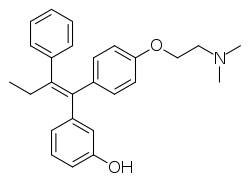Droloxifene
Droloxifene (INN, USAN) (former developmental code names FK-435, ICI-79280, K-060, K-21060E, RP-60850), also known as 3-hydroxytamoxifen, is a nonsteroidal selective estrogen receptor modulator (SERM) of the triphenylethylene group[1] that was developed originally in Germany and later in Japan for the treatment of breast cancer, osteoporosis in men and postmenopausal women, and cardiovascular disorders but was abandoned and never marketed.[3][4][5][6] It reached phase II and phase III clinical trials for these indications before development was discontinued in 2000.[6][7] The drug was found to be significantly less effective than tamoxifen in the treatment of breast cancer in two phase III clinical trials.[7][8]
 | |
| Clinical data | |
|---|---|
| Other names | FK-435; ICI-79280; K-060; K-21060E; RP-60850; 3-Hydroxytamoxifen; 3-OH-TAM |
| Routes of administration | Oral |
| Pharmacokinetic data | |
| Elimination half-life | 19–37 hours[1][2] |
| Identifiers | |
IUPAC name
| |
| CAS Number | |
| PubChem CID | |
| ChemSpider | |
| UNII | |
| KEGG | |
| ChEBI | |
| ChEMBL | |
| CompTox Dashboard (EPA) | |
| ECHA InfoCard | 100.102.640 |
| Chemical and physical data | |
| Formula | C26H29NO2 |
| Molar mass | 387.523 g·mol−1 |
| 3D model (JSmol) | |
SMILES
| |
InChI
| |
Droloxifene is an analogue of tamoxifen, specifically 3-hydroxytamoxifen, but has 10- to 60-fold increased affinity for the estrogen receptor[9] and reduced partial estrogen agonistic activity.[5][10] It causes a dose-dependent decrease in luteinizing hormone and follicle-stimulating hormone levels, indicating that it has antigonadotropic activity, and dose-dependently increases sex hormone-binding globulin levels, indicating that it has estrogenic activity in the liver.[2] Similarly to tamoxifen, droloxifene has partial estrogenic effects in the uterus.[11] Unlike tamoxifen, droloxifene does not produce DNA adduct or liver tumors in animals.[2]
See also
- Afimoxifene (4-hydroxytamoxifen)
- Endoxifen (N-desmethyl-4-hydroxytamoxifen)
References
- Michael Oettel; Ekkehard Schillinger (6 December 2012). Estrogens and Antiestrogens II: Pharmacology and Clinical Application of Estrogens and Antiestrogen. Springer Science & Business Media. pp. 158, 299. ISBN 978-3-642-60107-1.
- Andrea Manni (15 January 1999). Endocrinology of Breast Cancer. Springer Science & Business Media. pp. 298–. ISBN 978-1-59259-699-7.
- J. Elks (14 November 2014). The Dictionary of Drugs: Chemical Data: Chemical Data, Structures and Bibliographies. Springer. pp. 472–. ISBN 978-1-4757-2085-3.
- I.K. Morton; Judith M. Hall (31 October 1999). Concise Dictionary of Pharmacological Agents: Properties and Synonyms. Springer Science & Business Media. pp. 106–. ISBN 978-0-7514-0499-9.
- JORDAN V. CRAIG; B.J.A. Furr (5 February 2010). Hormone Therapy in Breast and Prostate Cancer. Springer Science & Business Media. pp. 200–. ISBN 978-1-59259-152-7.
- http://webcache.googleusercontent.com/search?q=cache:5syveMj6PR8J:adisinsight.springer.com/drugs/800000847+&cd=1&hl=en&ct=clnk&gl=us
- Eckhard Ottow; Hilmar Weinmann (8 September 2008). Nuclear Receptors as Drug Targets. John Wiley & Sons. pp. 153–. ISBN 978-3-527-62330-3.
- Vincent T. Devita; Samuel Hellman; Steven A. Rosenberg (1 April 2003). Progress in Oncology 2003. Jones & Bartlett Learning. pp. 217–. ISBN 978-0-7637-2064-3.
- Sotiris Missailidis (13 October 2008). Anticancer Therapeutics. John Wiley & Sons. pp. 165–. ISBN 978-0-470-69703-0.
- Bentham Science Publishers (February 1998). Current Pharmaceutical Design. Bentham Science Publishers. pp. 76–.
- Monica Morrow; Virgil Craig Jordan (2003). Managing Breast Cancer Risk. PMPH-USA. pp. 193–. ISBN 978-1-55009-260-8.